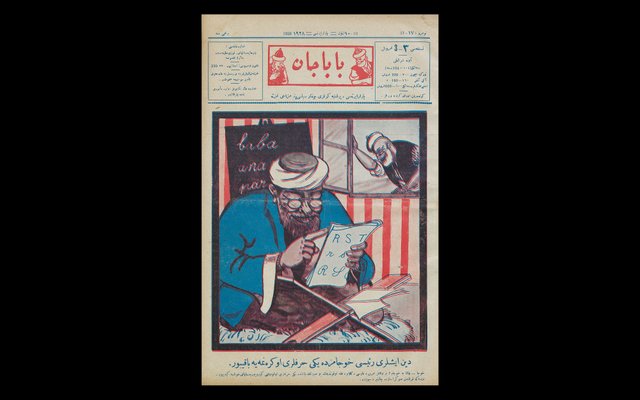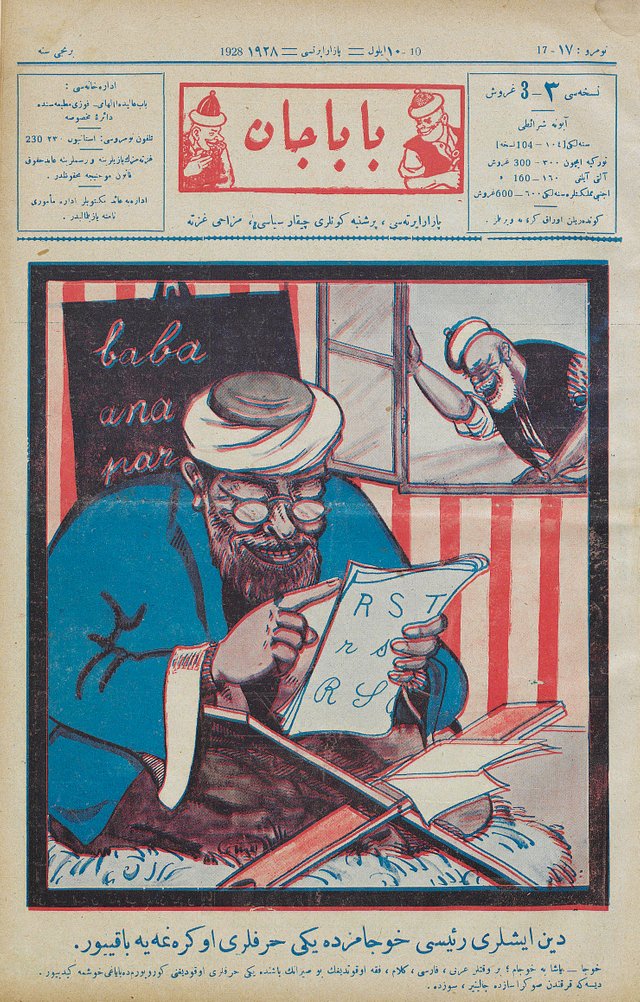170. Today in 1920s Turkey: 10 September 1928 (Alphabet Reform, Senior Citizen’s Edition)

(Cover illustration, Babacan, 10 September 1928, no. 17, page 1.)
Türkçe
Din işleri reisi hocamız da yeni harfleri öğrenmeye bakıyor.
Hoca: Yaşa be hocam; bir vakitler Arabi, Farsi, kelam , fıkıh , okuttuğun bu sıranın başında yeni harfleri okuduğunu görüyorum da bayağı hoşuma gidiyor. Desene kırkından sonra saz da çalınır, söz de.
English
Our head of religious affairs is also looking to learn the new letters.
Hodja: Hooray my hodja/teacher; I am seeing that you are reading the new letters at the same desks where you used to teach Arabic, Farsi, religious scriptures and jurisprudence and I am quite pleased. That is to say, after forty, one can learn to play the lute or read.
Comments:
The latter part of 1928 was abuzz with preparations for alphabet reform in Turkey. The print media, which had a greater stake in ensuring their readership learned the new letters, was especially keen on promoting the reform: illustrations such as this one served to underscore the various demographics that must participate in this change in order to function within the modern, nascent Turkish state.
Changing the alphabet from Arabic to Latin letters was a measure devised in August 1928. The reform, which would be carried out in haste, would become law on 1 December of the same year. From that point onward, all publications and signage would switch to the new alphabet. This meant that the entire nation (or more specifically, those who participated in public life) had only a few months to learn the new letters. This fast-approaching deadline explains the press’s motivation to mobilize readers to embrace the new alphabet sooner than later.
Learning any alphabet is a task most closely associated with primary school and children. Yet because people of all ages are affected by the change, it was important to highlight that adults, and even the elderly, are expected to hit the books and acquire new knowledge, perhaps for the first time since their youth. This is why today’s illustration focuses on an older man’s efforts to master the new letters. In fact, this man is no ordinary old man but rather, he is a teacher himself. Thus, he provides a good example of both demographics (seniors and teachers) stepping up to learn something new, even though traditionally, they are generally not expected to do so.
There were many reasons the alphabet was changed in 1928, the most noble of which was to eliminate illiteracy and fuel mass enlightenment. This goal was based in the belief that the Arabic alphabet was harder to master than the Latin letters, which are more straightforward. But of course, there were other reasons for this change as well, such as secularizing the state and education by weakening its ties with religion and the Islamic world, which universally used the Arabic alphabet. On the other hand, the adoption of the Latin letters served to more closely align the new Turkish state with its European neighbors and counterparts by creating a public space that appears more Western vis-à-vis the new alphabet. Thus, it is no coincidence that the “teacher/hodja” featured in the picture is a religious teacher who, according to the text, used to teach Arabic, Farsi, and Qur’an-related subjects.

(Cover illustration, Babacan, 10 September 1928, no. 17, page 1.)
Like what you see? Don’t forget to follow the “Today in 1920s Turkey” Steemit account @yasemin-gencer, or follow me on Twitter to receive notifications for new posts @1920sTurkey.
@soteyapanbot'u takip ederseniz, gunluk oylamalardan faydalanabilirsiniz.